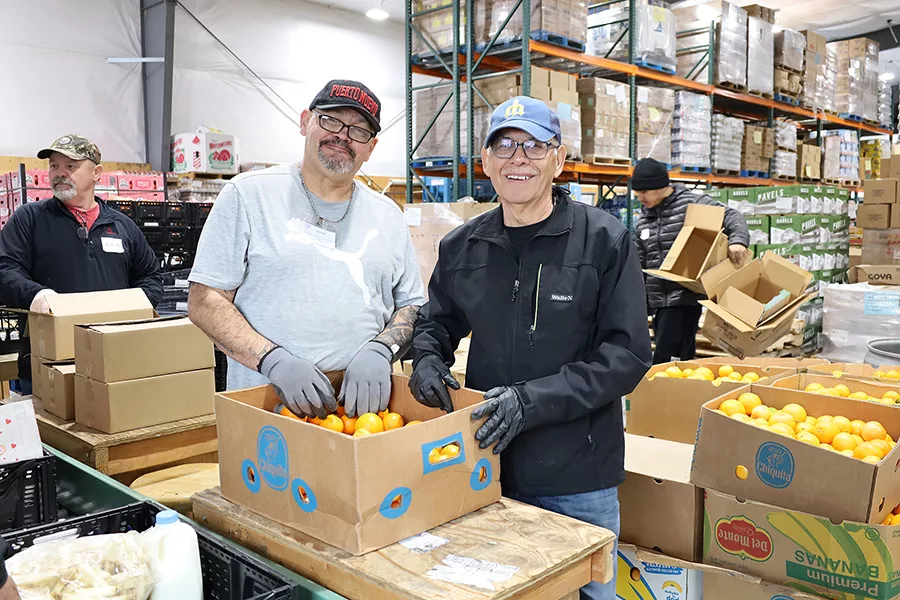
Home » Volunteers step up to serve nearly 1,500 people each week
Helping to help others
Volunteers step up to serve nearly 1,500 people each week
They can receive food, clothing and even medical aid for free

Volunteers at St. Vincent de Paul Food Bank help provide food to between 1,425 and 1,500 families each week. Victor Cardenas, left, and Martin Fabian hand out oranges at the food bank, with volunteer Blaine Blank on the far left.
Photo by Rachel VisickMarch 31, 2025
Every Wednesday, the warehouse at 215 S. Sixth Ave. in Pasco comes alive with activity. Cars fill the parking lot and surrounding streets and people line up around the side of the building, emerging later with bags and carts full of food and clothing.
The building is home to St. Vincent de Paul Food Bank and Community Services, which opens its doors at 11 a.m. once a week to those in need.
Refugees, the poor, the underemployed, the homeless, those looking for work, addicts and recovering addicts – all are welcome, said Lindy Styer, the organization’s president. St. Vincent de Paul aims to aid the hungry with an emphasis on dignity.
Nearly 1,500 people show up each week during the five hours the food bank is open, with an average of 1,393 families per week so far in 2025.
That number has nearly doubled in the past couple of years, Styer said. In 2021-22, an average of 827 families showed up each week.
Those who come to the food bank can get access to food, clothing and even medical aid – all for free.
A team of volunteers – many of them seniors – help to serve those seeking assistance and more are always needed.
St. Vincent de Paul was founded in Pasco in 1960, when the organization helped just a handful of families in need. Its mission is to “feed the hungry, clothe the naked, grow in holiness,” Styer said. The Pasco site is part of the Spokane Catholic Diocese.
The food bank is also part of a larger legacy – the original Society of St. Vincent de Paul was founded in France in 1833, and today works in 4,428 parish-based conferences across the United States.
How to receive help
For those seeking food, the first step is to line up between 11 a.m. to 4 p.m. on Wednesdays. Many line up earlier to secure a spot.
No proof of need or financial information needs to be disclosed, only the individual’s name, phone number and address, as well as the names and ages of family members.
Registered participants are given at least one ticket to receive their food, sometimes multiple tickets if they are picking up food for multiple family members. The tickets determine how many boxes of food they can have.
Those who aren’t registered will have to fill out an information card, which can be done at the food bank.
St. Vincent de Paul gets food donations from 2nd Harvest, Northwest Harvest, Blue Mountain Action Council, and various food drives and grocery stores. Using grant funding, the organization occasionally buys food as well.

St. Vincent de Paul Food Bank serves food from 11 a.m. to 4 p.m. each Wednesday thanks to about 70 volunteers, many of them retirees. From right, Teresa Lutomski, Art Flores and Edalinda Ramirez hand out food.
| Photo by Rachel VisickVolunteers put together balanced “menus” so that proteins, produce and dairy are available to those seeking food each week. Each volunteer is stationed by a particular food item, from lentils to tomatoes, behind a rolling conveyor belt.
As participants walk down the line, moving a plastic crate along the rollers, they can choose whether to take an item at each station.
Participants are encouraged to bring their own bags to take the food home, and some even bring wagons.
Specific bags are prepared for those who are homeless, containing more shelf-stable and transportable items like peanut butter, crackers and canned items with pull tabs. Paper plates and bottled water might also be included.
Sometimes the line can be long, stretching halfway around the outside of the building, but the process is efficient. Styer had previously worked as an airport supervisor and agent, so she knows about processing people efficiently and with dignity.
The parking lot outside has been reconfigured to provide spaces for those who need accessible parking, but sometimes it’s just not an option for people to come in person. While the food bank focuses its efforts on its Sixth Avenue building, if someone in need calls the organization, volunteers can try to find a way to deliver food.
Styer said that a couple of volunteers have even dropped off food to a single mom with cancer.
More than food
St. Vincent de Paul’s services go beyond providing food to those in need. There’s also a clothing boutique maintained by volunteers.
Donated clothes are carefully sorted, cleaned if dirty and sometimes even mended. Then, participants can come in and fill up a large trash bag with clothing. Off to the side, a small children’s play area keeps kids busy so their parents can freely shop around the boutique.
Baby diapers are available in small bundles, and baby boxes, filled with clothing for infants, are available for expecting mothers. Styer said they’re often in demand – an average of three boxes are taken each week.
Occasionally, the clothing boutique gets donations of kitchenware or office supplies, and the organization keeps a small “pantry” in the back. If the front desk gets a request for one of those items, they’ll give it away.
Kadlec also has donated hygiene kits, which St. Vincent de Paul usually must spend money on, to give participants toothpaste, deodorant and other hygiene products.
Outside the building, the Range, Kadlec’s mobile medical unit, treats patients for free. Staffed by a doctor and a few nurses, the Range can provide vaccinations and make referrals for treatment.

In addition to food, St. Vincent de Paul also provides a free clothing boutique. Above, volunteer Pam Peterson sorts clothing in the boutique’s back room. The food bank also partners with Kadlec to provide free mobile medical care.
| Photo by Rachel VisickVolunteering
Like many of the volunteers at St. Vincent de Paul, Styer, 68, is retired. About 70 people volunteer, helping sort through clothing, checking people in at a registration desk, and passing out food.
Only two workers are paid, Styer said – the warehouse manager and his assistant. The rest of the operation is all volunteer-driven.
It’s a big need for the organization – since volunteers have their own lives, it’s often a moving target, Styer said. “We’re always seeking volunteers,” she said.
Styer was herself only a volunteer for a year before becoming the president, a role she’s held for two months. The organization is one with many leadership opportunities, Styer said, but for volunteers that just want to be an extra pair of hands, there’s a need for that, too.
Though St. Vincent de Paul is a Catholic organization and each Wednesday’s volunteering kicks off with a prayer, volunteers come from all walks of life and don’t have to be religious.
“The diversity we have here is just incredible,” Styer said, with volunteers from hospital administrators to beauty salon owners.
There’s an effort to have bilingual volunteers as well, especially at the front desk.
Volunteers need background checks, orientations and a safeguarding orientation to understand how to keep vulnerable people safe.
Those who are interested can call St. Vincent de Paul and leave a message at 509-544-9315.
Senior Times Charitable Giving & Nonprofits
KEYWORDS April 2025
Related Articles
Related Products





